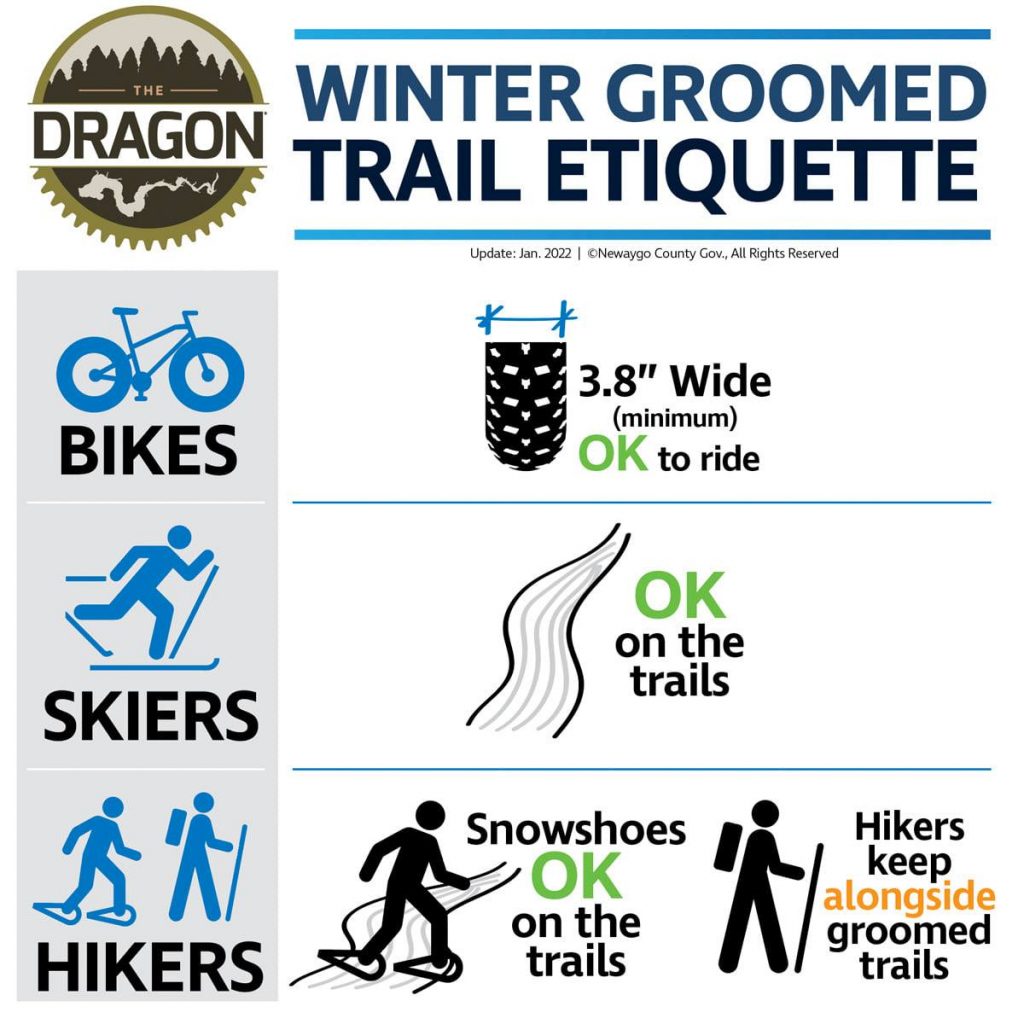Mountain Biking Trail Etiquette: Ride Right, Respect Rules

As an affiliate, we may earn from qualifying purchases. We get commissions for purchases made through links on this website. You can read more on our Affiliate Disclaimer here.
Mountain biking trail etiquette emphasizes respect for others, safety, and nature conservation. Riders should yield to pedestrians, equestrians, and uphill cyclists.
Mountain biking combines adventure and fitness, often taking cyclists through stunning, but sensitive natural landscapes.
Understanding trail etiquette is crucial for preserving these environments and ensuring a harmonious experience for everyone. Key principles include staying on marked trails to avoid damaging flora and fauna, not startling wildlife, and leaving no trace of your visit.
Proper trail conduct also helps maintain a positive image of the mountain biking community, wards off potential trail closures, and fosters a sense of camaraderie among outdoor enthusiasts.
Adopting trail etiquette not only enhances your own riding experience but also contributes to sustainable trail management and the enjoyment of others.
Introduction To Mountain Biking Etiquette
Introduction to Mountain Biking Etiquette plays a key role in keeping the trails safe and enjoyable. Riders of all levels share these paths, from casual enthusiasts to seasoned professionals.
Understanding and adhering to unwritten codes and explicit trail rules ensures a respect-driven and harmonious environment for everyone.
The Unwritten Code Among Bikers
Seasoned mountain bikers abide by a set of informal guidelines known as the unwritten code. These norms govern behavior on the trails, promoting sportsmanship and consideration. Elements of the code include:
- Yielding to uphill riders due to their right of way
- Alerting others when passing
- Assisting fellow bikers in need
- Keeping trails clean by not littering
Importance Of Following Trail Rules
Trail rules enhance safety and preserve the environment. Specific rules vary by location but universally include:
- Staying on marked paths to protect wildlife and vegetation
- Respecting trail closures and conditions for community safety
- Controlling speed to prevent accidents
- Riding only on trails open to bikers to respect boundaries
Following these rules strengthens the mountain biking community and respects the natural areas we cherish.

Credit: usacycling.org
Right Of Way On The Trail
Maintaining safety and respect among mountain bikers means knowing trail etiquette. One crucial aspect of this is the right of way. Trails teem with different users: hikers, bikers, and sometimes even horses. Without clear rules, these paths could turn chaotic. This section explains who should yield and how to share trails peacefully.
Knowing Who Yields To Whom
First, bikers must understand yielding protocols. Mountain bikers follow a simple hierarchy:
- Bikers yield to equestrians and hikers.
- Downhill riders yield to uphill riders.
This system prioritizes safety and preserves trail conditions.
Navigating Multi-use Paths
Multi-use paths host various activities like walking, cycling, and sometimes even motorized vehicles. Here’s how to navigate them:
- Stay aware of surroundings and listen for others.
- Use a bell or voice to signal presence.
- Always pass on the left, after announcing intention.
Respecting these rules ensures a safe, enjoyable experience for everyone on the trail.
Leaving No Trace Behind
Exploring mountain biking trails is an adventure that thrills many. Nature offers a playground, but it’s fragile. It’s our role to keep it pristine. It’s more than just a ride; it’s respecting the environment. By understanding trail etiquette, we leave no trace behind. We ensure that the beauty and health of our natural surroundings remain for future rides.
Environmental Impact Of Biking
Mountain biking can affect nature. Riding creates trails and shapes the land. With each turn of the wheels, bikers can leave a mark. That’s why trail conservation is vital. The goal is to enjoy the ride while minimizing our footprint.
Principles For Minimizing Damage
To reduce impact, adopting certain principles is key. This ensures that the trails we love stay healthy and accessible.
- Stick to marked paths: This keeps the surrounding habitat undisturbed.
- Avoid wet trails: Riding after rain can erode the trail and damage the terrain.
- Control your bike: Skidding and sliding can harm the trail surface.
- Carry out trash: What you take in, you must take out. Leave no wrappers or bottles behind.
- Respect wildlife: Keep a safe distance from animals. Don’t feed them or disrupt their homes.
Remember, our actions shape the trail for those who follow. Let’s leave nothing but tire tracks, and take nothing but pictures. Together, we can ensure our mountain biking adventures are sustainable and rewarding for years to come.
Managing Your Speed
When mountain biking, speed adds thrills but requires control. Proper speed management ensures safety for you and others on the trail. Mastering speed control can make rides more enjoyable and prevent crashes.
Controlling Pace For Safety
Knowing when to speed up or slow down is key to trail safety. Here are tips for controlling your pace:
- Scan ahead for obstacles and changes in terrain.
- Use gear shifts wisely to maintain a steady pace uphill and downhill.
- Stay aware of other riders and be ready to adjust your speed.
- Practice braking to stop quickly and safely when needed.
Adjusting Speed To Trail Conditions
Trails are unpredictable. Your speed should match the trail’s current state. Below are adjustments to consider:
| Trail Condition | Speed Adjustment |
|---|---|
| Wet or Slippery | Reduce speed, brake early, and use caution. |
| Rocky or Uneven | Slow down, focus on balance and choose the best path. |
| Dense Vegetation | Decrease speed to avoid hidden obstacles. |
| High Traffic | Lower speed and communicate with other trail users. |
Overtaking And Passing Etiquette
Mountain biking is not just about racing down trails or enjoying the great outdoors; it is also about sharing those trails responsibly. Knowing how to overtake and pass fellow bikers is a key part of this trail etiquette. This ensures everyone’s safety and enjoyment on the trail. Now, let’s explore the proper ways to pass and the signals you should be using.
Proper Ways To Pass Other Bikers
When you’re approaching another biker from behind and you’re ready to pass, it’s vital to pass safely and courteously:
- Communicate your intent well in advance.
- Slow down to avoid startling the rider in front.
- Pass on the left when possible, as it’s generally expected.
- Give the rider ahead enough space—no close shaves!
- Thank the rider for letting you pass—friendliness goes a long way.
Verbal And Non-verbal Passing Signals
Communication on the trail can prevent accidents. Use these signals:
| SIGNAL | MEANING |
|---|---|
| “On your left” | You plan to pass on the left side. |
| “On your right” | You plan to pass on the right side. |
| Bell ring | You are approaching and wish to pass. |
| Hand wave | You want to communicate your passing intention. |
| Nod of the head | Non-verbal acknowledgment of the other rider. |
Remember, using a combination of verbal and non-verbal cues ensures clarity and maintains good vibes on the trails.

Credit: www.thedragon.us
Trail Care And Maintenance
Caring for mountain bike trails is crucial. It keeps the paths safe and enjoyable for everyone. As a rider, giving back and respecting the trails should be a priority. This ensures the trails last long for future riders.
Volunteering For Trail Work
Volunteering is an excellent way to contribute to trail sustainability. Giving your time helps maintain the trails we love.
- Join local groups that organize work days.
- Learn about trail building and repair.
- Contribute to special projects like new trail sections.
Every hour you spend helps keep the trails in great condition. Your effort supports the biking community.
Respecting Trail Closures And Reroutes
Obeying signs for closures and reroutes is vital. This helps with trail conservation. Trails might close for several reasons:
| Reason for Closure | Action You Should Take |
|---|---|
| Environmental protection | Respect boundaries and avoid closed areas. |
| Trail repair or construction | Follow detours; give workers space to operate safely. |
| Seasonal changes | Check for updates before you ride. |
Adhering to these guidelines helps prevent trail damage. It keeps both the rider and the environment secure.
Handling Accidents And Emergencies
Out on the trails, the ride pulses with excitement. Yet, being prepared for accidents and emergencies is key. Smart riders know this gritty side of mountain biking. This guide ensures one knows the essentials for trail crisis management.
First Aid For Bikers
When mishaps hit, first aid becomes the first line of defense. A basic understanding of trailside first aid can turn a biker into a lifesaver.
- Carry a first aid kit. Your pack should have bandages, antiseptic wipes, and pain relievers.
- Learn wound care. Know how to clean cuts and stop bleeding.
- Recognize fracture signs. Immobilize the affected area if a break is suspected.
- Stay warm. Shock can cool the body quickly. Pack emergency blankets.
- Be hydration-wise. Always have water to prevent dehydration.
Regularly refresh your first aid skills. Courses are widely available.
Emergency Procedures On Remote Trails
Remote trails pose greater risks. Planning is crucial for safety.
Keep calm and assess the situation. Use the acronym P.R.I.C.E:
| P | R | I | C | E |
|---|---|---|---|---|
| Protect | Rest | Ice | Compress | Elevate |
Signal for help if needed. Whistles carry further than voices.
- Inform someone of your ride plan.
- Carry a charged mobile phone and a portable battery.
- Consider a GPS beacon for uncharted areas.
For serious injuries, prioritize evacuation. If solo, send GPS coordinates to emergency contacts.
Respecting Wildlife And Flora
Embracing the rush of mountain biking involves more than personal
thrills; it’s about coexisting with nature.
While navigating trails, the delicate balance
between recreation and conservation stands paramount.
Respecting wildlife and flora not only preserves the
environment but enhances our outdoor experiences.
Encounters With Animals On Trails
When we pedal into the wild, we become guests in the homes
of countless creatures. Peaceful coexistence is key.
- Maintain distance to avoid stressing wildlife.
- Stay on marked trails, limiting disturbance.
- Alert animals of your presence with noise.
Preserving Natural Habitats
| Action | Benefit |
|---|---|
| Avoid shortcuts | Prevents soil erosion and plant damage. |
| Clean your gear | Stops the spread of invasive species. |
| Respect closures | Allows restoration and animal breeding. |
Our interactions with the trail environment should leave minimal
footprints and ensure that the ecosystems we enjoy remain
intact and vibrant for future adventurers.
Sharing Tips And Recommendations
Welcome to the essential guide on mountain biking trail etiquette! Before hitting those thrilling trails, remember that sharing trails with fellow bikers, hikers, and wildlife requires awareness and respect.
This part of our post dives into handy tips and recommendations for fostering positive trail experiences for everyone. From mentoring novices to choosing the right trail, let’s make every ride a blueprint for responsible biking.
Mentoring New Mountain Bikers
- Teach Trail Respect: Instill the ‘Leave No Trace’ principles in beginners.
- Model Best Practices: Demonstrate proper passing signals and right-of-way etiquette.
- Safety First: Emphasize the importance of wearing helmets and checking gear.
- Stay Patient: Accommodate their pace and offer encouragement.
Suggesting Trails Based On Ability Levels
| Ability Level | Trail Recommendations |
|---|---|
| Beginner | Green circles; smooth, wide trails with gentle slopes. |
| Intermediate | Blue squares; trails with varied terrain and moderate challenges. |
| Advanced | Black diamonds; steep, technical trails for experienced riders. |
Use trail-rating systems as a guide to match bikers with suitable challenges. Encourage riders to start easy and progress as their skills develop. Remind them that it’s okay to walk sections beyond their ability. Safety and enjoyment should always be priorities.

Credit: www.denverpost.com
In Conclusion: Promoting A Positive Trail Culture
Creating a welcoming environment on mountain trails is crucial. Respect and courtesy make rides enjoyable for everyone. Let’s explore the impact of good manners on the mountain biking experience and ways to foster responsible biking practices.
The Impact Of Etiquette On Biking Experience
Good trail manners shape our adventures. They maintain a safe, fun space for riders. Here’s how etiquette enhances the experience:
- Reduces Conflicts: Respect for others keeps the peace on trails.
- Protects Nature: Staying on paths preserves the wild areas we cherish.
- Safety for All: Signaling and yielding prevent accidents, keeping the ride safe.
Encouraging Responsible Mountain Biking
We can all champion responsible mountain biking. It starts with our actions. Tips for responsibility on the trails include:
- Stay on marked paths to protect the habitat.
- Be kind and pass with care to ensure everyone’s safety.
- Leave no trace to keep the trails clean for others.
Embracing these habits, we create a culture of care and respect. This makes our trails a treasure for future riders.
Frequently Asked Questions For Mountain Biking Trail Etiquette
Who Has The Right Of Way Mountain Bikers Or Hikers?
Hikers generally have the right of way over mountain bikers on trails. Bikers should yield to pedestrians for safety.
What Is The Etiquette For Passing A Mountain Bike Race?
To pass a mountain bike race safely, yield to racers, notify when overtaking, stay clear of the course, be courteous, and quickly resume your activity.
What Are You Supposed To Wear Mountain Biking?
For mountain biking, wear a helmet, gloves, and appropriate eyewear. Choose moisture-wicking clothing, padded shorts, and sturdy shoes for safety and comfort.
Conclusion
As we wrap up, remember that mountain biking is not just about conquering trails. It’s about respect – for nature, fellow riders, and yourself.
Embrace trail etiquette; it ensures a safer, more enjoyable adventure for everyone. Keep shredding, but tread responsibly.
Happy trails to you!

Steven is a professional cyclist and his passion is cycling. He has been cycling for the last 6 years and he loves using bikes while outing as well. Based on his experiences with the different types of bikes; he is sharing his opinions about various bikes so that a beginner can start right away. Find him on Twitter @thecyclistguy Happy Biking.




